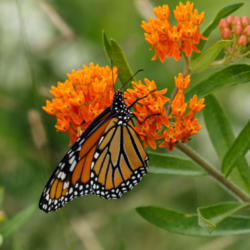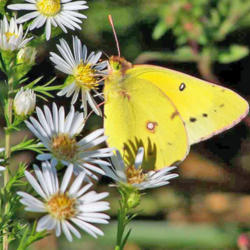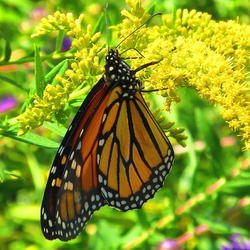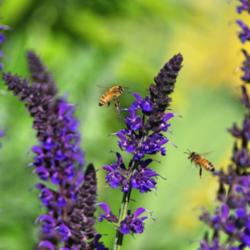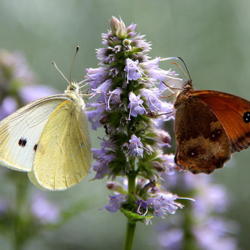Many of us envision a peaceful paradise where butterflies float, serenely sipping nectar from the beauty we have created. For me, the reality of a butterfly garden is humming, vibrant, and thrilling beyond anything I ever could have imagined. Here are some tips for creating a butterfly garden of your own.
(1) Choose plants that are larval hosts for the butterfly species that you would like to attract.
Butterflies tend to hang out the most in gardens where they find their host plants, so the important first questions are:
Which butterflies would you like to attract?
Which plants do those butterflies need for their life cycle?
There are many resources on the Web that can help you learn more about plants that specific butterflies use to lay their eggs on. Here are some links that I found helpful for choosing butterfly larval host plants:
http://www.dallasbutterflies.c...
http://www.gardenswithwings.co...
http://www.naba.org/chapters/n...
http://www.xerces.org/wp-conte...
http://nathistoc.bio.uci.edu/b...
(2) Focus on plants and butterflies that are native to your region.
Plants and the pollinators they support and depend on have evolved together over hundreds of years. For this reason, native plants generally do a better job of attracting local butterflies than non-natives. By the same token, you'll want to make sure that the native plants you choose are native to your region of the country, so that the butterflies that live in your area will seek them out to lay their eggs on.
- To zero in on butterflies that live where you do, BAMONA (Butterflies and Moths of North America) has a really cool tool that allows you to enter the county you live in, and it then brings up a list of butterflies (and moths) that have been sighted in your area. If you click on a link for, eg., Monarch, it will take you to the BAMONA Monarch page, which includes photographs and general information, including information on the Monarch's larval host plants. Enter information for your own region and try it out! http://www.butterfliesandmoths...
- To focus on plants that are native to your area, the Lady Bird Johnson Wildflower Center has an equally cool tool that allows you to search the native plant database by the state you live in. Click on your state and browse through the list of native plants in your area. Find one in your backyard and click on it--eg, a plant native to my state (Maryland) is the flowering dogwood (Cornus florida). Clicking on the link takes me to the plant entry for Cornus florida, which contains information on its beneficial aspects, including the fact that the flowering dogwood is a host plant for the Spring Azure butterfly. Find your own state and try it out!
http://www.wildflower.org/coll...
- A source I have found particularly valuable is the authoritative world-wide larval host plant database maintained by the Natural History Museum in London. http://www.nhm.ac.uk/research-... This database allows you to search by either host plant or butterfly species. Caveat: You have to use/Google the Latin names for both the host plants and the butterflies (and moths) they support.
(3) Be sure to include nectar-rich plants in your garden.
The larval host plants are critical for the caterpillar stage, but once the adult butterfly emerges, he or she will need nectar-rich plants to feed on. Planting a variety of nectar plants will ensure that the butterflies that visit or emerge in your garden will linger to enjoy the buffet you've created.
One particularly helpful site I found for identifying key nectar plants is the Xerces Society, which provides pollinator plant lists by region of the country. Find your own region and see how many pollinator plants you already have or might like to get!
- http://www.xerces.org/fact-sheets/
The Web has many resources to help identify nectar-rich plants for butterflies. Here are a couple of other sources that I found helpful.
- https://butterfly-conservation.org/files/100-best-butterfly-nectar-plants.pdf
- http://www.pollinator.org/PDFs/MonarchGardenPlants.pdf
(4) Don't use pesticides or buy plants that have been treated with pesticides.
Caterpillars eat their host plants. If the plants have pesticide residue on them, the caterpillars will sicken and die. Avoiding pesticide use is good for the rest of nature, too. Birds are sickened when they consume insects that have eaten pesticide-ridden plants. Bees bring the residue back to their colonies and die. The pesticides go into our ground water and contaminate it. So what can we do instead?
- Use biocontrol methods whenever possible. A variety of herbs and other plants attract beneficial insects, which will help keep garden pests under control. Here is a useful list of plants that will help attract beneficial insects to your garden. http://ferncreekdesign.org/ben...
- Try cutting off and disposing of affected plant parts. In many cases, some judicious pruning combined with the beneficial insects you'll be attracting will be enough to control an unwanted pest.
- If you feel you must use a spray to control a pest, use an organic treatment such as Neem Oil, and use it late in the day when pollinators are less active.
- Be careful where you buy plants, as many suppliers use insecticides, and so the parsley you just purchased as a host plant for the black swallowtail butterflies you want will kill any caterpillars that try to use it. Search for suppliers that offer pesticide-free plants, or grow from seed.
- Learn to live with some of the "bad guys." Left to itself, nature will create a delicate system of checks and balances that will curb excesses effectively. The cost is imperfection, but the reward is a garden humming and vibrant with life.
(5) Expect a multitude.
A successful butterfly garden will attract not only butterflies, but also other pollinators. Far from my previous mental image of butterflies floating serenely through the air, my garden is now fairly abuzz. When I look up synonyms for "vibrant," the list I find is fitting: abubble, animated, bustling, flourishing, lively, thriving, and teeming. Antonyms include asleep, dead, inactive, and lifeless.
Today I stood outside while Cabbage White and Skipper Butterflies swirled and skipped around me, finding partners. A Monarch darted quickly from milkweed to milkweed, laying one or two eggs on each plant. A Tiger Swallowtail fluttered by, exploring the phlox. Bees hummed busily. The birds flocked to the sunflowers and coneflower seeds.
It's late summer and many of my blossoms are in decline, but the pollinators and other wildlife provide me with endless joy and satisfaction. My butterfly garden is everything I imagined--and more! I hope you will enjoy your butterfly garden, too.
